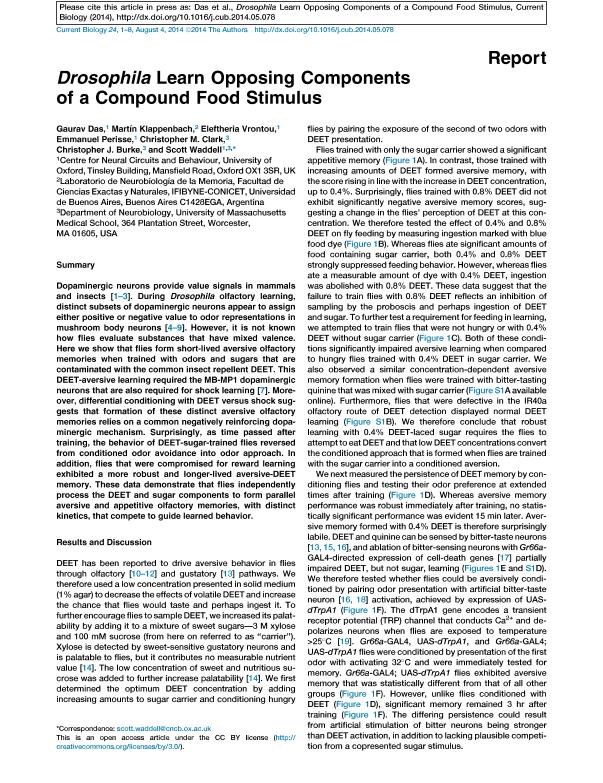Artículo
Drosophila Learn Opposing Components of a Compound Food Stimulus
Das, Gaurav; Klappenbach, Martín ; Vrontou, Eleftheria; Persisse, Emmanuel; Clark, Cristopher; Burke, Christopher; Waddell, Scott
; Vrontou, Eleftheria; Persisse, Emmanuel; Clark, Cristopher; Burke, Christopher; Waddell, Scott
 ; Vrontou, Eleftheria; Persisse, Emmanuel; Clark, Cristopher; Burke, Christopher; Waddell, Scott
; Vrontou, Eleftheria; Persisse, Emmanuel; Clark, Cristopher; Burke, Christopher; Waddell, Scott
Fecha de publicación:
07/2014
Editorial:
Cell Press
Revista:
Current Biology
ISSN:
0960-9822
Idioma:
Inglés
Tipo de recurso:
Artículo publicado
Clasificación temática:
Resumen
Dopaminergic neurons provide value signals in mammals and insects [1–3]. During Drosophila olfactory learning, distinct subsets of dopaminergic neurons appear to assign either positive or negative value to odor representations in mushroom body neurons [4–9]. However, it is not known how flies evaluate substances that have mixed valence. Here we show that flies form short-lived aversive olfactory memories when trained with odors and sugars that are contaminated with the common insect repellent DEET. This DEET-aversive learning required the MB-MP1 dopaminergic neurons that are also required for shock learning [7]. Moreover, differential conditioning with DEET versus shock suggests that formation of these distinct aversive olfactory memories relies on a common negatively reinforcing dopaminergic mechanism. Surprisingly, as time passed after training, the behavior of DEET-sugar-trained flies reversed from conditioned odor avoidance into odor approach. In addition, flies that were compromised for reward learning exhibited a more robust and longer-lived aversive-DEET memory. These data demonstrate that flies independently process the DEET and sugar components to form parallel aversive and appetitive olfactory memories, with distinct kinetics, that compete to guide learned behavior.
Palabras clave:
Drosophila
,
Memory
Archivos asociados
Licencia
Identificadores
Colecciones
Articulos(IFIBYNE)
Articulos de INST.DE FISIOL., BIOL.MOLECULAR Y NEUROCIENCIAS
Articulos de INST.DE FISIOL., BIOL.MOLECULAR Y NEUROCIENCIAS
Citación
Das, Gaurav; Klappenbach, Martín; Persisse, Emmanuel; Vrontou, Eleftheria; Waddell, Scott; Clark, Cristopher; et al.; Drosophila Learn Opposing Components of a Compound Food Stimulus; Cell Press; Current Biology; 24; 15; 7-2014; 1723-1730
Compartir
Altmétricas



